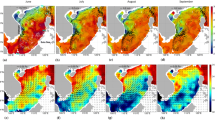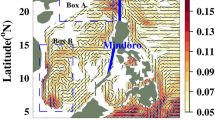Abstract
The Luzon Strait is the main impact pathway of the Kuroshio on the circulation in South China Sea (SCS). Based on the analysis of the 1997–2007 altimeter data and 2005–2006 output data from a high resolution global HYCOM model, the total Luzon Strait Transport (LST) has remarkable subseasonal oscillations with a typical period of 90 to 120 days, and an average value of 1.9 Sv into SCS. Further spectrum analysis shows that the temporal variability of the LST at different depth is remarkable different. In the upper layer (0–300 m), westward inflow has significant seasonal and subseasonal variability. In the bottom layer (below 1 200 m), eastward outflow exhibits remarkable seasonal variability, while subseasonal variability is also clear. In the intermediate layer, the westward inflow is slightly bigger than the eastward outflow, and both of them have obvious seasonal and subseasonal variability. Because the seasonal variation of westward inflow and eastward out-flow is opposite, the total transport of intermediate layer exhibits significant 50–150 days variation, without obvious seasonal signals. The westward Rossby waves with a period of 90 to 120 days in the Western Pacific have very clear correlationship with the Luzon Strait Transport, this indicates that the interaction between these westward Rossby waves and Kuroshio might be the possible mechanism of the subseasonal variation of the LST.
Similar content being viewed by others
References
Ashok K, Guan Z, Yamagata T. 2001. Impact of the Indian Ocean dipole on the relationship between Indian Ocean monsoon rainfall and ENSO. Geophys Res Lett, 28: 4499–4502
Bleck R. 2002. An oceanic general circulation model framed in hybrid isopycnic-Cartesian coordinates. Ocean Modelling. 37: 55–88
Chassignet E P, Smith L T, Halliwell G R, et al. 2003. North Atlantic Simulations with the Hybrid Coordinate Ocean Model (HYCOM): Impact of the Vertical Coordinate Choice, Reference Pressure, and Termoobaricity. J Phys Oceanogr, 33: 2504–2526
Chassignet E P, Hurlburt H E, Metzger E J, et al. 2009. U S GODAE: Global Ocean Prediction with the HY-brid Coordinate Ocean Model (HYCOM). Oceanography, 22(2): 64–75
Chelton D B, Schlax M G. 1996. Global observations of oceanic Rossby waves. Science, 272: 234–238
Chen C T, Huang M H. 1996. Amid-depth front separating the South China Seawater and the Philippine Seawater. J Oceanogr, 52: 17–25
Chu P, Li R. 2000. South China Sea isopycnal-surface circulation. J Phys Oceanogr, 30: 1438–2419
Jing C S, Li L, Zhu D Y. 2006. The propagation character of SSH mesoscale variation in the western Pacific and the South China Sea. China Science Bulletin (in Chinese), 51(20): 2422–2428
Gordon A L. 1986. Interocean exchange of thermocline water. J Geophys Res, 91: 5037–5046
Lebedev K V, Yaremchuk M I. 2000. A diagnostic study of the Indonesian throughflow. J Geophys Res, 105: 11243–11258
Li L, Wu B. 1989. A Kuroshio Loop in South China Sea? -On Circulations of the Northeastern South China Sea. Journal of Oceanography in Taiwan Strait, 8(1): 89–95
Li L, Qu T. 2006. Thermohaline circulation in the Deep South China Sea basin as inferred fromoxygen distributions. J Geophys Res, 111: C05017
Liang W D, Yang Y J, Tang T Y, et al. 2008. Kuroshio in the Luzon Strait, J Geophys Res, v113, C08048, doi:10.1029/2007JC004609
McBride J L, Haylock M R, Nichols N. 2003. Relation-ships between the Maritime Continent heat source and the El Ni?no-Southern Oscillation phenomenon. J Clim, 16: 2905–2914
Metzger E J, Hurlburt H E. 1996. Coupled dynamics of the South China Sea, the Sulu Sea, and the Pacific Ocean. J Geophys Res, 101: 12331–12352
Metzger E J, Hurlburt H E. 2001. The nondeterministic nature of Kuroshio penetration and eddy shedding in the South China Sea. J Phys Oceanogr, 31: 1712–1732
Neale R B, Slingo J M. 2003. The Maritime Continent and its role in the global climate: a GCM study. J Clim, 16: 834–848
Qu T, Kim Y Y, Yaremchuk M, et al. 2004. Can Luzon strait transport play a role in conveying the impact of ENSO to the South China Sea? J Clim, 17(18): 3643–3656
Qu T, Du Y, Sasaki H. 2006. South China Sea throughflow: a heat and freshwater conveyor. Geophys Res Lett, 33: L23617, doi: 10.1029/2006GL028350
Shaw P T. 1989. The intrusion of water masses into the sea southwest of Taiwan. J Geophys Res, 94(C12): 18213–18226
Song Y T. 2006. Estimation of interbasin transport using ocean bottom pressure: theory and model for Asian marginal seas. J Geophys Res, 111, C11S19, doi: 10.1029/2005JC003189
Tian J, Yang Q, Liang X, et al. 2006. The observation of Luzon strait transport. Geophys Res Lett, 33: L19607, doi:10.1029/2006GL026272
Tozuka T, Qu T, Yamagata T. 2007. Effect of South China Sea throughflow on the Makassar strait throughflow. Geophys Res Lett, 34: L12612, doi:10.1029/2007GL030420
Wang D, Liu Q, Huang R, et al. 2006. Interannual variability of the South China Sea throughflow inferred from wind data and an ocean data assimilation product. Geophys Res Lett, 33: L14605, doi: 10.1029/2006GL026316
Wyrtki K. 1961. Physical oceanography of the southeast Asian waters. Naga Report, 2: 1–195
Xue H, Chai F, Pettigrew N, et al. 2004. Kuroshio intrusion and the circulation in the South China Sea. J Geophys Res, 109, C02017, doi: 10.1029/2002JC001724
Yaremchuk M, Qu T. 2004. Seasonal variability of the circulation near the Philippine coast. J Phys Oceanogr, 34: 844–855
Yu Z, Shen S, McCreary J P, et al. 2007. South China Sea throughflow as evidenced by satellite images and numerical experiments. Geophys Res Lett, 34, L01601, doi: 10.1029/2006GL028103
Yuan D. 2002. A numerical study of the South China Sea deep circulation and its relation to the Luzon Strait transport. Acta Oceanologica Sinica, 21(2): 187–202
Author information
Authors and Affiliations
Corresponding author
Additional information
Foundation item: The Ministry of Science and Technology of China (National Key Program for Developing Basic Science) under contract No. 2007CB411803; the National 863 High-tech Program under contract No. 2008AA09A402.
Rights and permissions
About this article
Cite this article
Zhang, Z., Zhao, W. & Liu, Q. Sub-seasonal variability of Luzon Strait Transport in a high resolution global model. Acta Oceanol. Sin. 29, 9–17 (2010). https://doi.org/10.1007/s13131-010-0032-0
Received:
Accepted:
Published:
Issue Date:
DOI: https://doi.org/10.1007/s13131-010-0032-0




